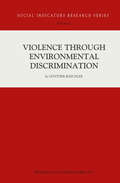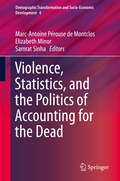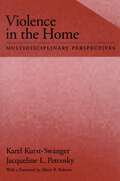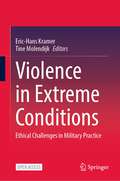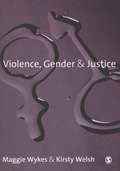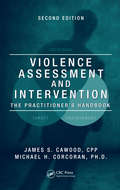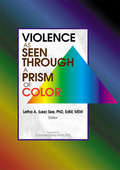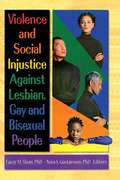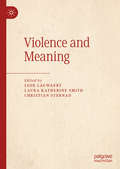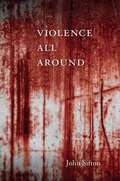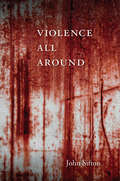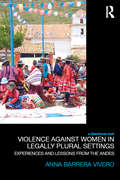- Table View
- List View
Violence Through Environmental Discrimination: Causes, Rwanda Arena, and Conflict Model (Social Indicators Research Series #2)
by Günther BaechlerSince all-out interstate wars for the time being seem to belong to the past, con flict studies focus more and more on domestic conflicts. This is a broad field, not only because the arbitrary line between war and sub-war violence disap pears and the analyst is confronted with phenomena reaching from criminal violence and clashes between communities to violent conflicts of long duration and civil wars with massacres and genocides as their characteristics. It is also because there are so many different types of conflicts to be analyzed, so many different types of behavior to be studied, whereas there is often little informa tion available on what is really going on. Against the background of internal conflicts, which tend to be as protracted as diffuse in terms of time, intensity, actors, and their goals, this study aims to follow a specific pathway through the current thicket of violent circumstances. It focuses on causation patterns by exploring the causal role of the environ mental factor in the genesis of violent conflicts occurring today and probably even more so tomorrow. This approach, which for once does not focus on a specific level of the conflict system, on one area in the conflict geography, or on a specific category of actors, analyzes causation dynamics.
Violence, Statistics, and the Politics of Accounting for the Dead (Demographic Transformation and Socio-Economic Development #4)
by Marc-Antoine Pérouse de Montclos Elizabeth Minor Samrat SinhaThis book examines the methodological problems of accounting for the dead in armed conflicts as well as how the process itself is open to manipulation and controversy. Inspired by the work of the International Practitioner Network of casualty recording organizations, the book features thematic analysis, case studies and historical discussion on the use of the body count towards political, humanitarian and military ends.The book begins with a strategic analysis of the body count that introduces a general discussion on the measurement of war violence; its treatment by the media, humanitarian organizations, governments and the military; and its legal and political implications. It then examines the accounting for civilian war casualties in past and future conflicts, investigates the way the International Committee of the Red Cross has dealt with the issue of missing persons and the identification of dead bodies in armed conflicts and explores the role of statistics in aid policy debates, especially in regards to humanitarian workers.Next, the book details the field of casualty recording as practiced by civil society organizations, with insights from a study of 40 practitioners. It also features narrative case studies that detail the ways human losses were documented during recent conflicts in Northeastern India (2006-2009) and Croatia (1991-1995). In addition, one case study looks at the usefulness of casualty recording in engaging policymakers on the impacts of particular technologies of violence.This book offers an insightful investigation into violence, statistics and the politics of accounting for the dead. It will appeal to a broad audience of policy-makers, human rights activists, humanitarian practitioners as well as academics.
Violence, Law and the Impossibility of Transitional Justice
by Catherine TurnerThe field of transitional justice has expanded rapidly since the term first emerged in the late 1990s. Its intellectual development has, however, tended to follow practice rather than drive it. Addressing this gap, Violence, Law and the Impossibility of Transitional Justice pursues a comprehensive theoretical inquiry into the foundation and evolution of transitional justice. Presenting a detailed deconstruction of the role of law in transition, the book explores the reasons for resistance to transitional justice. It explores the ways in which law itself is complicit in perpetuating conflict, and asks whether a narrow vision of transitional justice – underpinned by a strictly normative or doctrinal concept of law – can undermine the promise of justice. Drawing on case material, as well as on perspectives from a range of disciplines, including law, political science, anthropology and philosophy, this book will be of considerable interest to those concerned with the theory and practice of transitional justice.
Violence, Law and the Impossibility of Transitional Justice
by Catherine TurnerThe field of transitional justice has expanded rapidly since the term first emerged in the late 1990s. Its intellectual development has, however, tended to follow practice rather than drive it. Addressing this gap, Violence, Law and the Impossibility of Transitional Justice pursues a comprehensive theoretical inquiry into the foundation and evolution of transitional justice. Presenting a detailed deconstruction of the role of law in transition, the book explores the reasons for resistance to transitional justice. It explores the ways in which law itself is complicit in perpetuating conflict, and asks whether a narrow vision of transitional justice – underpinned by a strictly normative or doctrinal concept of law – can undermine the promise of justice. Drawing on case material, as well as on perspectives from a range of disciplines, including law, political science, anthropology and philosophy, this book will be of considerable interest to those concerned with the theory and practice of transitional justice.
Violence in the Home: Multidisciplinary Perspectives
by Karel Kurst-Swanger Jacqueline L. PetcoskyViolence in the home is one of the most damaging and widespread of social problems. It is an issue that cuts across all socioeconomic, racial, ethnic, gender, and age boundaries. This important book reviews the most current theoretical explanations of family violence and then links theory to practice. It looks at the systems and institutions that interact with families, which are mandated to provide protection and services, and explores the current debates surrounding family violence and public policy. In addition, Kurst-Swanger explores the role of power in abusive relationships and considers the short- and long-term consequences of abuse. This insightful book will be a practical resource for professionals and of interest to all those concerned with the far-reaching impact of family violence.
Violence in Extreme Conditions: Ethical Challenges in Military Practice
by Eric-Hans Kramer Tine MolendijkAs an organization operating under extreme conditions, the military is often confronted with destructive behavior from individuals, organizations, and societies. Written by experts from a variety of disciplines, this open access book reflects on confrontations with violence under extreme conditions and the various challenges that arise.By examining real first-hand accounts of soldiers’ deployments, the contributions shed new light on the multifaceted and sometimes hidden dynamics of destructive violent behavior and offer an ethical reflection on military practices. In addition, they address topics such as moral decision-making in violent contexts, military trauma, organizational change, and military ethics education.The interdisciplinary exploration of these topics has been the primary focus of Désirée Verweij, who was the Chair of Military Ethics at the Netherlands Defence Academy from 2008 to 2021. The contributions in this book are written in honor of her scholarly achievements and help to ensure that these important issues continue to receive attention. The book will appeal to scholars of military studies, organizational studies and military ethics, and to professionals and decisionmakers in military organizations.
Violence in America's Schools: Understanding, Prevention, and Responses
by R. Murray ThomasThe problem of violence in schools has not gone away despite radical reductions in violent crimes throughout the country over the last decade. Students continue to harrass, haze, and harm each other in a variety of ways, disrupting classrooms and whole schools. In the wake of the Columbine massacre, many focused on the worst kind of school violence: deadly assaults with dangerous weapons. But other forms of violence are more persistent, common, and just as destructive in many ways: fighting, sexual abuse, carrying weapons to school, vandalism, and assorted other crimes that happen behind the closed doors of elementary, middle, and high schools across the country. The consequences range from violent victimization and death, to the disruption of learning and fear among student bodies and teaching staffs. Here, Thomas provides a foundation for understanding why the violence occurs, preventing it from happening, and treating both offenders and victims after it happens.Using scores of case descriptions to illustrate the types of school violence and their treatment in recent years, the author skillfully shows readers how the problem of violence and crime in schools is an insidious issue that cannot go untreated. He offers both tested and proposed methods for dealing with a host of violence issues and a guide to planning treatment of the problem and its associated consequences. He answers the questions: What are prominent types of violence in American schools? What conditions contribute to those types of violence? What methods can be applied in an effort to reduce school violence? Readers will come away from this book with a greater understanding of the scope of violence in America's schools, and the myriad ways of addressing it.
Violence, Gender and the State: ‘Not Just’ A Legal Analysis
by Saumya UmaThis book examines the adequacy of laws in India as a response to sexual and gender-based violence against women. It addresses questions such as: is law doing enough in responding to violence against women in India? Where are the barriers and bottlenecks, particularly for women from marginalised communities? What can be done to ensure that justice is rendered? Based on women’s experience of violence, not solely on the basis of gender, but a combination of caste, class, and religious and gender identities, the book examines law as a response to gendered violence against women in India through the lens of intersectionality. It combines socio-legal and feminist analyses of relevant statutes on sexual and gender-based violence, their judicial interpretations, their implementation by law enforcement agencies, and their ramifications for women’s lives. This book will be of interest to academics, research scholars, and students in a range of disciplines, including law, women’s studies, gender and sexuality studies, victimology, sociology, political science, and human rights. It will also be useful for policymakers, advocates, judicial officers, paralegal workers, women’s rights campaigners, non-profit organisations and, globally, anyone interested in and concerned with justice for women in India.
Violence, Gender and the State: ‘Not Just’ A Legal Analysis
by Saumya UmaThis book examines the adequacy of laws in India as a response to sexual and gender-based violence against women. It addresses questions such as: is law doing enough in responding to violence against women in India? Where are the barriers and bottlenecks, particularly for women from marginalised communities? What can be done to ensure that justice is rendered? Based on women’s experience of violence, not solely on the basis of gender, but a combination of caste, class, and religious and gender identities, the book examines law as a response to gendered violence against women in India through the lens of intersectionality. It combines socio-legal and feminist analyses of relevant statutes on sexual and gender-based violence, their judicial interpretations, their implementation by law enforcement agencies, and their ramifications for women’s lives. This book will be of interest to academics, research scholars, and students in a range of disciplines, including law, women’s studies, gender and sexuality studies, victimology, sociology, political science, and human rights. It will also be useful for policymakers, advocates, judicial officers, paralegal workers, women’s rights campaigners, non-profit organisations and, globally, anyone interested in and concerned with justice for women in India.
Violence, Gender and Justice (PDF)
by Maggie WykesThis is a very impressive piece of thorough scholarship. It is an important book that highlights the need to consider gender when developing policies to respond to interpersonal violence. It is written in a clear and accessible style and should be required reading for all criminal justice students. - Dr Malcolm Cowburn, Sheffield Hallam University.
Violence Assessment and Intervention: The Practitioner's Handbook, Second Edition
by Florian James S. Cawood Michael H. Corcoran Ph.D.Behavioral science has revealed a wealth of information concerning violence assessment in a wide variety of situations, but the challenge confronted by those dealing with potentially hostile populations is the effective application of this knowledge. Now in its second edition, Violence Assessment and Intervention: The Practitioner‘s Handbook, Secon
Violence as Seen Through a Prism of Color
by Letha A SeeSo many parts of society target citizens of color for violence--what can be done? Violence as Seen Through a Prism of Color examines violence from a structural perspective, including violence in prisons, schools and colleges, churches, homes, and within political/corporate structures.This unique, hard-hitting book argues that individual violence stems from the structure of our society and its institutions. Most of the contributors are African- American educators and practitioners who have a thorough understanding of structural violence. Some have experienced political violence; others have expert knowledge of structural violence within the criminal justice system, educational institutions, and elsewhere--even in churches and homes. Their writings are undeniably, unflinchingly authentic--it is impossible not to be moved and enraged by what they have to say. The good news is that in addition to calling attention to the structural violence in our society they provide excellent insights on how the situation might be resolved.Violence as Seen Through a Prism of Color shows: that much of the violence within the criminal justice system stems from decisions made at the highest levels of government that minority offenders are much more frequently convicted and more harshly sentenced than their white counterparts how cultural racism contributes to the construction of motives for lynching, hate crime, and police violence against Americans of color such as Abner Louima, Amadou Diallo, and Rodney King how the judicial system encourages black on black violence by neglecting to halt criminal activities in non-white neighborhoods how, in the words of Mahatma Gandhi, ”Poverty is the worst form of violence”You’ll also learn: how corporations are amassing great wealth through privatizing prisons and conscripting the labor of non-violent African-American prisoners how racial profiling affects people of color how the media has exploited black men imprisoned for minor drug offenses how and why violence occurs in and against the black churchHelpful charts and tables (like one that names the corporations that use prison labor) supplement the material--you’ll be surprised at what you learn! Extensive references are included at the end of each chapter.
Violence as Seen Through a Prism of Color
by Letha A SeeSo many parts of society target citizens of color for violence--what can be done? Violence as Seen Through a Prism of Color examines violence from a structural perspective, including violence in prisons, schools and colleges, churches, homes, and within political/corporate structures.This unique, hard-hitting book argues that individual violence stems from the structure of our society and its institutions. Most of the contributors are African- American educators and practitioners who have a thorough understanding of structural violence. Some have experienced political violence; others have expert knowledge of structural violence within the criminal justice system, educational institutions, and elsewhere--even in churches and homes. Their writings are undeniably, unflinchingly authentic--it is impossible not to be moved and enraged by what they have to say. The good news is that in addition to calling attention to the structural violence in our society they provide excellent insights on how the situation might be resolved.Violence as Seen Through a Prism of Color shows: that much of the violence within the criminal justice system stems from decisions made at the highest levels of government that minority offenders are much more frequently convicted and more harshly sentenced than their white counterparts how cultural racism contributes to the construction of motives for lynching, hate crime, and police violence against Americans of color such as Abner Louima, Amadou Diallo, and Rodney King how the judicial system encourages black on black violence by neglecting to halt criminal activities in non-white neighborhoods how, in the words of Mahatma Gandhi, ”Poverty is the worst form of violence”You’ll also learn: how corporations are amassing great wealth through privatizing prisons and conscripting the labor of non-violent African-American prisoners how racial profiling affects people of color how the media has exploited black men imprisoned for minor drug offenses how and why violence occurs in and against the black churchHelpful charts and tables (like one that names the corporations that use prison labor) supplement the material--you’ll be surprised at what you learn! Extensive references are included at the end of each chapter.
Violence and Social Injustice Against Lesbian, Gay, and Bisexual People
by Lacey Sloan Nora GustavssonViolence and Social Injustice Against Lesbian, Gay, and Bisexual People helps you look past the stereotypical picture of violence against sexual minorities--the public physical assaults on gay, lesbian, bisexual, and transgendered youth by hypermasculine male thugs--and directs you toward the many daily acts of quiet violence that go on, unhindered, in the workaday settings of our legal, social, educational, and law-enforcement institutions. You’ll learn about the frightening prevelance of complacency, homophobic ignorance, and apathy that pervades our police departments, courts, high schools, and churches. Also, armed with this critical insight and statistical research, you’ll be better equipped to wage a non-violent war of fairness and mutual respect against the daily, senseless violence of policy and practice that threatens to render gay, lesbian, bisexual, and transgendered people unwelcome and battered citizens in their own communities.You’ll find that Violence and Social Injustice Against Lesbian, Gay, and Bisexual People is ideal for aiding social workers, counselors, teachers, and criminal justice officials in removing the unseen acts of violence from the policies and practices of the public sector. These and other specific areas will give you the information and the fortitude necessary to evoke positive change in your community: legal issues relating to same-sex marriage the connection between social injustice and violence violence against sexual minority youth sexual identity and ethnic minorities practice and policy recommendationsAs this book shows, violence against sexual minorities can be subtly woven into the very fabric of some of our most long-standing, respected social institutions. For too long, the sexual minorities of color, for example, and the lesbian who suffers physical assault at the hands of a partner, have had little or no help from social workers, law enforcement, or education for fear of receiving either complete negligence or increased antagonism. But now, in Violence and Social Injustice Against Lesbian, Gay, and Bisexual People, you’ll find the facts and tools necessary for turning the ugliness of communal violence into social justice for people of all sexual orientations.
Violence and Social Injustice Against Lesbian, Gay, and Bisexual People
by Lacey Sloan Nora GustavssonViolence and Social Injustice Against Lesbian, Gay, and Bisexual People helps you look past the stereotypical picture of violence against sexual minorities--the public physical assaults on gay, lesbian, bisexual, and transgendered youth by hypermasculine male thugs--and directs you toward the many daily acts of quiet violence that go on, unhindered, in the workaday settings of our legal, social, educational, and law-enforcement institutions. You’ll learn about the frightening prevelance of complacency, homophobic ignorance, and apathy that pervades our police departments, courts, high schools, and churches. Also, armed with this critical insight and statistical research, you’ll be better equipped to wage a non-violent war of fairness and mutual respect against the daily, senseless violence of policy and practice that threatens to render gay, lesbian, bisexual, and transgendered people unwelcome and battered citizens in their own communities.You’ll find that Violence and Social Injustice Against Lesbian, Gay, and Bisexual People is ideal for aiding social workers, counselors, teachers, and criminal justice officials in removing the unseen acts of violence from the policies and practices of the public sector. These and other specific areas will give you the information and the fortitude necessary to evoke positive change in your community: legal issues relating to same-sex marriage the connection between social injustice and violence violence against sexual minority youth sexual identity and ethnic minorities practice and policy recommendationsAs this book shows, violence against sexual minorities can be subtly woven into the very fabric of some of our most long-standing, respected social institutions. For too long, the sexual minorities of color, for example, and the lesbian who suffers physical assault at the hands of a partner, have had little or no help from social workers, law enforcement, or education for fear of receiving either complete negligence or increased antagonism. But now, in Violence and Social Injustice Against Lesbian, Gay, and Bisexual People, you’ll find the facts and tools necessary for turning the ugliness of communal violence into social justice for people of all sexual orientations.
Violence and Security on Campus: From Preschool through College
by James Alan Fox Harvey BursteinThis comprehensive, evidence-based examination looks at violence and security across the entire spectrum of education, from preschool through college.In Violence and Security on Campus: From Preschool through College two expert authors take an evidence-based look at this important issue, dispelling myths and misconceptions about the problem and offering appropriate responses to it. Their book examines patterns, trends, correlations, and causes of violence, crime, and disorder in diverse educational settings, from elementary schools through colleges and universities. It reviews data and research evidence related to forms of violence, from bullying to murder, and it explores the varied security concerns that confront schools of different levels.In addition to describing the nature and extent of the school violence problem, which is often divergent from media reports, the authors point to other security issues that need to be considered and addressed by administrators and security personnel. Finally, they assess a variety of policy responses and security solutions—some popular yet ineffective, some challenging yet promising—offering advice that will enhance the security of any institution of learning.
Violence and Messianism: Jewish Philosophy and the Great Conflicts of the Twentieth Century (Routledge Jewish Studies Series)
by Petar BojanićViolence and Messianism looks at how some of the figures of the so-called Renaissance of "Jewish" philosophy between the two world wars - Franz Rosenzweig, Walter Benjamin and Martin Buber - grappled with problems of violence, revolution and war. At once inheriting and breaking with the great historical figures of political philosophy such as Kant and Hegel, they also exerted considerable influence on the next generation of European philosophers, like Lévinas, Derrida and others. This book aims to think through the great conflicts in the past century in the context of the theory of catastrophe and the beginning of new messianic time. Firstly, it is a book about means and ends – that is, about whether good ends can be achieved through bad means. Second, it is a book about time: peace time, war time, time it takes to transfer from war to peace, etc. Is a period of peace simply a time that excludes all violence? How long does it take to establish peace (to remove all violence)? Building on this, it then discusses whether there is anything that can be called messianic acting. Can we – are we capable of, or allowed to – act violently in order to hasten the arrival of the Messiah and peace? And would we then be in messianic time? Finally, how does this notion of messianism – a name for a sudden and unpredictable event – fit in, for example, with our contemporary understanding of terrorist violence? The book attempts to understand such pressing questions by reconstructing the notions of violence and messianism as they were elaborated by 20th century Jewish political thought. Providing an important contribution to the discussion on terrorism and the relationship between religion and violence, this book will appeal to theorists of terrorism and ethics of war, as well as students and scholars of Philosophy, Jewish studies and religion studies.
Violence and Messianism: Jewish Philosophy and the Great Conflicts of the Twentieth Century (Routledge Jewish Studies Series)
by Petar BojanićViolence and Messianism looks at how some of the figures of the so-called Renaissance of "Jewish" philosophy between the two world wars - Franz Rosenzweig, Walter Benjamin and Martin Buber - grappled with problems of violence, revolution and war. At once inheriting and breaking with the great historical figures of political philosophy such as Kant and Hegel, they also exerted considerable influence on the next generation of European philosophers, like Lévinas, Derrida and others. This book aims to think through the great conflicts in the past century in the context of the theory of catastrophe and the beginning of new messianic time. Firstly, it is a book about means and ends – that is, about whether good ends can be achieved through bad means. Second, it is a book about time: peace time, war time, time it takes to transfer from war to peace, etc. Is a period of peace simply a time that excludes all violence? How long does it take to establish peace (to remove all violence)? Building on this, it then discusses whether there is anything that can be called messianic acting. Can we – are we capable of, or allowed to – act violently in order to hasten the arrival of the Messiah and peace? And would we then be in messianic time? Finally, how does this notion of messianism – a name for a sudden and unpredictable event – fit in, for example, with our contemporary understanding of terrorist violence? The book attempts to understand such pressing questions by reconstructing the notions of violence and messianism as they were elaborated by 20th century Jewish political thought. Providing an important contribution to the discussion on terrorism and the relationship between religion and violence, this book will appeal to theorists of terrorism and ethics of war, as well as students and scholars of Philosophy, Jewish studies and religion studies.
Violence and Meaning
by Lode Lauwaert Laura Katherine Smith Christian SternadThis edited collection explores the problem of violence from the vantage point of meaning. Taking up the ambiguity of the word ‘meaning’, the chapters analyse the manner in which violence affects and in some cases constitutes the meaningful structure of our lifeworld, on individual, social, religious and conceptual levels. The relationship between violence and meaning is multifaceted, and is thus investigated from a variety of different perspectives within the continental tradition of philosophy, including phenomenology, post-structuralism, critical theory and psychoanalysis. Divided into four parts, the volume explores diverging meanings of the concept of violence, as well as transcendent or religious violence- a form of violence that takes place between humanity and the divine world. Going on to investigate instances of immanent and secular violence, which occur at the level of the group, community or society, the book concludes with an exploration of violence and meaning on the individual level: violence at the level of the self, or between particular persons. With its focus on the manifold of relations between violence and meaning, as well as its four part focus on conceptual, transcendent, immanent and individual violence, the book is both multi-directional and multi-layered.
Violence All Around
by John SiftonA human rights lawyer travels to hot zones around the globe before and after 9/11 to document abuses by warlords, terrorists, and counterterrorism forces. John Sifton reminds us that human rights advocates can only shame the world into better behavior; to invoke rights is to invoke the force to uphold them, including the very violence they deplore.
Violence All Around
by John SiftonA human rights lawyer travels to hot zones around the globe before and after 9/11 to document abuses by warlords, terrorists, and counterterrorism forces. John Sifton reminds us that human rights advocates can only shame the world into better behavior; to invoke rights is to invoke the force to uphold them, including the very violence they deplore.
VIOLENCE AGAINST WOMEN WENK C: What Everyone Needs to Know® (What Everyone Needs to Know)
by Jacqui TrueViolence against women and girls (VAWG) is a longstanding problem that has increasingly come to the forefront of international and national policy debates and news: from the US reauthorization of the Violence against Women Act and a United Nations declaration to end sexual violence in war, to coverage of gang rapes in India, cyberstalking and "revenge porn", honor killings, female genital mutilation, and international trafficking. Yet, while we frequently read or learn about particular experiences or incidents of VAWG, we are often unaware of the full picture. Jacqui True, an internationally renowned scholar of globalization and gender, provides an expansive frame for understanding VAWG in this book. Among the questions she addresses include: What are we talking about when we discuss VAWG? What kinds of violence does it encompass? Who does it affect most and why? What are the risk factors for victims and perpetrators? Does VAWG occur at the same level in all societies? Are there cultural explanations for it? What types of legal redress do victims have? How reliable are the statistics that we have? Are men and boys victims of gender-based violence? What is the role of the media in exacerbating VAWG? And, what sorts of policy and advocacy routes exist to end VAWG? This volume addresses the current state of knowledge and research on these questions. True surveys our best understanding of the causes and consequences of violence against women in the home, local community, workplace, public, and transnationally. In so doing, she brings together multidisciplinary perspectives on the problem of violence against women and girls, and sets out the most promising policy and advocacy frameworks to end this violence.
Violence Against Women in Legally Plural settings: Experiences and Lessons from the Andes (Law, Development and Globalization)
by Anna BarreraThis book addresses a growing area of concern for scholars and development practitioners: discriminatory gender norms in legally plural settings. Focusing specifically on indigenous women, this book analyses how they, often in alliance with supporters and allies, have sought to improve their access to justice. Development practitioners working in the field of access to justice have tended to conceive indigenous legal systems as either inherently incompatible with women’s rights or, alternatively, they have emphasised customary law’s advantageous features, such as its greater accessibility, familiarity and effectiveness. Against this background – and based on a comparison of six thus far underexplored initiatives of legal and institutional change in Ecuador, Peru, and Bolivia – Anna Barrera Vivero provides a more nuanced, ethnographic, understanding of how women navigate through context-specific constellations of interlegality in their search for justice. In so doing, moreover, her account of ongoing political debates and local struggles for gender justice grounds the elaboration of a comprehensive conceptual framework for understanding the legally plural dynamics involved in the contestation of discriminatory gender norms.
Violence Against Women in Legally Plural settings: Experiences and Lessons from the Andes (Law, Development and Globalization)
by Anna BarreraThis book addresses a growing area of concern for scholars and development practitioners: discriminatory gender norms in legally plural settings. Focusing specifically on indigenous women, this book analyses how they, often in alliance with supporters and allies, have sought to improve their access to justice. Development practitioners working in the field of access to justice have tended to conceive indigenous legal systems as either inherently incompatible with women’s rights or, alternatively, they have emphasised customary law’s advantageous features, such as its greater accessibility, familiarity and effectiveness. Against this background – and based on a comparison of six thus far underexplored initiatives of legal and institutional change in Ecuador, Peru, and Bolivia – Anna Barrera Vivero provides a more nuanced, ethnographic, understanding of how women navigate through context-specific constellations of interlegality in their search for justice. In so doing, moreover, her account of ongoing political debates and local struggles for gender justice grounds the elaboration of a comprehensive conceptual framework for understanding the legally plural dynamics involved in the contestation of discriminatory gender norms.
Violence against Women in Families and Relationships [4 volumes]: [4 volumes] (Non-ser.)
by Eve S. Buzawa Evan StarkThis comprehensive overview of domestic violence against women and children in America covers the services meant to combat it, the legal approaches to prosecuting it, the public's attitudes toward it, and the successes and failures of systems meant to address it.The fight to end domestic violence consists of community-based services for battered women, laws and policies to combat the problem, a broad spectrum of frequently-innovative programs to protect or otherwise support abused women and children, a dramatic shift in media portrayals of violence against women, and a growing public critique of unacceptable forms of power and control in relationships. These volumes offer another weapon in that battle.Violence against Women in Families and Relationships takes stock of all of the ways in which legislation, programs and services, and even public attitudes have impacted victims, offenders, and communities over the last few decades. Contributors pay special attention to how race, class, and cultural differences affect the experience of abuse. They explore the efficacy of interventions, and they provide compelling real-life examples to illustrate issues and challenges. Our society has made an enormous investment in stopping abuse in families and relationships, but numerous questions still remain. Many of those questions are answered in these pages, as experts uncover the realities of domestic violence and the toll it takes on families, individuals, communities, and society at large.
